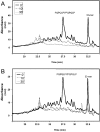Comparative biochemical analysis of three bacterial prolyl endopeptidases: implications for coeliac sprue
- PMID: 15245330
- PMCID: PMC1134072
- DOI: 10.1042/BJ20040907
Comparative biochemical analysis of three bacterial prolyl endopeptidases: implications for coeliac sprue
Abstract
Prolyl endopeptidases have potential for treating coeliac sprue, a disease of the intestine caused by proteolytically resistant peptides from proline-rich prolamins of wheat, barley and rye. We compared the properties of three similar bacterial prolyl endopeptidases, including the known enzymes from Flavobacterium meningosepticum (FM) and Sphingomonas capsulate (SC) and a novel enzyme from Myxococcus xanthus (MX). These enzymes were interrogated with reference chromogenic substrates, as well as two related gluten peptides (PQPQLPYPQPQLP and LQLQPFPQPQLPYPQPQLPYPQPQLPYPQPQPF), believed to play a key role in coeliac sprue pathogenesis. In vitro and in vivo studies were conducted to evaluate the activity, specificity and acid/protease stability of the enzymes. All peptidases were relatively resistant to acid, pancreatic proteases and membrane peptidases of the small intestinal mucosa. Although their activities against reference substrates were similar, the enzymes exhibited substantial differences with respect to chain length and subsite specificity. SC hydrolysed PQPQLPYPQPQLP well, but had negligible activity against LQLQPFPQPQLPYPQPQLPYPQPQLPYPQPQPF. In contrast, the FM and MX peptidases cleaved both substrates, although the FM enzyme acted more rapidly on LQLQPFPQPQLPYPQPQLPYPQPQLPYPQPQPF than MX. Whereas the FM enzyme showed a preference for Pro-Gln bonds, SC cleaved both Pro-Gln and Pro-Tyr bonds with comparable efficiency, and MX had a modest preference for Pro-(Tyr/Phe) sites over Pro-Gln sites. While a more comprehensive understanding of sequence and chain-length specificity may be needed to assess the relative utility of alternative prolyl endopeptidases for treating coeliac sprue, our present work has illustrated the diverse nature of this class of enzymes from the standpoint of proteolysing complex substrates such as gluten.
Figures





Similar articles
-
Fermentation, purification, formulation, and pharmacological evaluation of a prolyl endopeptidase from Myxococcus xanthus: implications for Celiac Sprue therapy.Biotechnol Bioeng. 2005 Dec 20;92(6):674-84. doi: 10.1002/bit.20643. Biotechnol Bioeng. 2005. PMID: 16136593
-
Combination enzyme therapy for gastric digestion of dietary gluten in patients with celiac sprue.Gastroenterology. 2007 Aug;133(2):472-80. doi: 10.1053/j.gastro.2007.05.028. Epub 2007 May 21. Gastroenterology. 2007. PMID: 17681168
-
Structural and mechanistic analysis of two prolyl endopeptidases: role of interdomain dynamics in catalysis and specificity.Proc Natl Acad Sci U S A. 2005 Mar 8;102(10):3599-604. doi: 10.1073/pnas.0408286102. Epub 2005 Feb 28. Proc Natl Acad Sci U S A. 2005. PMID: 15738423 Free PMC article.
-
Prolyl endopeptidases.Cell Mol Life Sci. 2007 Feb;64(3):345-55. doi: 10.1007/s00018-006-6317-y. Cell Mol Life Sci. 2007. PMID: 17160352 Free PMC article. Review.
-
[Proline specific peptidases and their specific inhibitors].Yakugaku Zasshi. 1991 Jul;111(7):345-58. doi: 10.1248/yakushi1947.111.7_345. Yakugaku Zasshi. 1991. PMID: 1783984 Review. Japanese.
Cited by
-
Efficient Hydrolysis of Gluten-Derived Celiac Disease-Triggering Immunogenic Peptides by a Bacterial Serine Protease from Burkholderia gladioli.Biomolecules. 2021 Mar 17;11(3):451. doi: 10.3390/biom11030451. Biomolecules. 2021. PMID: 33802942 Free PMC article.
-
Selection of Gut-Resistant Bacteria and Construction of Microbial Consortia for Improving Gluten Digestion under Simulated Gastrointestinal Conditions.Nutrients. 2021 Mar 19;13(3):992. doi: 10.3390/nu13030992. Nutrients. 2021. PMID: 33808622 Free PMC article.
-
The cultivable human oral gluten-degrading microbiome and its potential implications in coeliac disease and gluten sensitivity.Clin Microbiol Infect. 2013 Sep;19(9):E386-94. doi: 10.1111/1469-0691.12249. Epub 2013 May 28. Clin Microbiol Infect. 2013. PMID: 23714165 Free PMC article.
-
Role of intestinal bacteria in gliadin-induced changes in intestinal mucosa: study in germ-free rats.PLoS One. 2011 Jan 13;6(1):e16169. doi: 10.1371/journal.pone.0016169. PLoS One. 2011. PMID: 21249146 Free PMC article.
-
Significant Hydrolysis of Wheat Gliadin by Bacillus tequilensis (10bT/HQ223107): a Pilot Study.Probiotics Antimicrob Proteins. 2018 Dec;10(4):662-667. doi: 10.1007/s12602-017-9331-5. Probiotics Antimicrob Proteins. 2018. PMID: 28948492
References
-
- Kabashima T., Fujii M., Meng Y., Ito K., Yoshimoto T. Prolyl endopeptidase from Sphingomonas capsulata: isolation and characterization of the enzyme and nucleotide sequence of the gene. Arch. Biochem. Biophys. 1998;358:141–148. - PubMed
-
- Rennex D., Hemmings B. A., Hofsteenge J., Stone S. R. cDNA cloning of porcine brain prolyl endopeptidase and identification of the active-site seryl residue. Biochemistry. 1991;30:2195–2203. - PubMed
-
- Yoshimoto T., Kanatani A., Shimoda T., Inaoka T., Kokubo T., Tsuru D. Prolyl endopeptidase from Flavobacterium meningosepticum: cloning and sequencing of the enzyme gene. J. Biochem. (Tokyo) 1991;110:873–878. - PubMed
-
- Yoshimoto T., Miyazaki K., Haraguchi N., Kitazono A., Kabashima T., Ito K. Cloning and expression of the cDNA encoding prolyl oligopeptidase (prolyl endopeptidase) from bovine brain. Biol. Pharm. Bull. 1997;20:1047–1050. - PubMed
-
- Yoshimoto T., Walter R., Tsuru D. Proline-specific endopeptidase from Flavobacterium. Purification and properties. J. Biol. Chem. 1980;255:4786–4792. - PubMed
Publication types
MeSH terms
Substances
Grants and funding
LinkOut - more resources
Full Text Sources
Other Literature Sources
Medical

